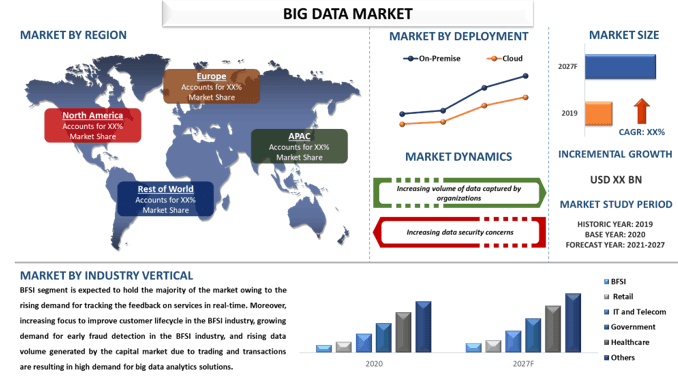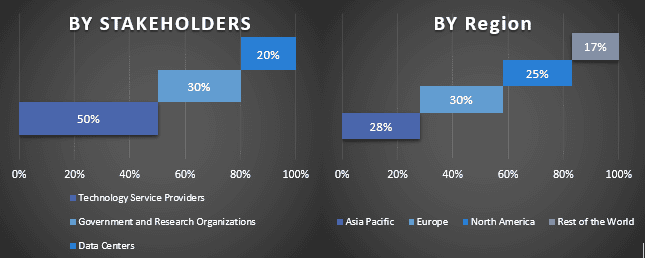- Home
- About Us
- Industry
- Services
- Reading
- Contact Us
Big Data Market: Current Analysis and Forecast (2021-2027)
Emphasis on Component (Solutions, Services), Deployment (On-premise, Cloud); Industry Vertical (BFSI, Retail, IT & Telecom, Government, Healthcare, Others); Region/ Country

The Big Data Market is expected to grow at a CAGR of 12% during the forecast period. Big data is a major part of every organization to manage, process, and streamline large data sets in real-time as well as it improves the organization’s decision-making capability. Rising investments and spending on various technological projects by the government and key players is acting as a growth catalyst to the industry. Furthermore, various factors such as plummeting technology costs and the development of open-source big data software frameworks, data connectivity through hybrid and multi-cloud environments, and incorporation of digital transformation in top-level strategies are expected to drive the adoption of big data solutions and services. With the emergence of big data technology, the need to process and analyze massive data economically and faster is a crucial thing for enterprises worldwide. Moreover, the demand for big data analytics is increasing among enterprises to process data cost-effectively and at a faster speed. Organizations in all industries are harnessing the power of big data by deploying big data solutions to efficiently manage and analyze big data for actionable insights.
Insights Presented in the Report
“Amongst component, the solution segment is expected to witness the highest CAGR during the forecast period”
Based on component, the market is segmented into solutions and services. The solutions segment is expected to hold the largest big data market. The growth is attributed to the increasing demand for big data platforms such as Microsoft azure, Cloudera, tableau, and collibra in various industry verticals.
“Amongst deployment, the cloud segment is expected to witness the highest CAGR during the forecast period”
Based on deployment, the market is segmented into on-premises and cloud. The cloud segment is expected to hold the majority of the big data market during the forecast period. The cloud enables fast and secure networks. Also cloud networks save a lot of upfront installation costs, which later can be used in other operations. Moreover, the cloud deployment model scales a solution’s capacity to handle enormous network application traffic. With the adoption of these solutions, small enterprises are able to collect and analyze data, thus improving customer services. Presently, the demand for cloud-based big data solutions is increasing over their on-premises counterparts, owing to the various advantages offered by the cloud deployment model.
“Amongst industry vertical, it and telecom segment is expected to witness the highest CAGR during the forecast period”
Based on industry vertical, the market is segmented into BFSI, Retail, IT and telecom, government, healthcare, utility, manufacturing, and others. BFSI segment is expected to hold the majority of the market. The rising demand for tracking the feedback on services in real-time is driving the adoption of big data in the BFSI industry. Increasing focus to improve customer lifecycle in the BFSI industry, growing demand for early fraud detection in the BFSI industry, and rising data volume generated by the capital market due to trading and transactions are resulting in high demand for big data analytics solutions.
“Asia Pacific to witness significant growth during the forecast period”
The Asia Pacific region is expected to grow significantly during the forecast period. The growing adoption of IoT devices and development of the insurance and banking industry and penetration of new technologies like connected devices are adding to the big data market growth in the region. China and India hold the majority of the big data market in the region. The growing prowess in science and technology and government policies are expected to drive the big data market. Asia pacific. The APAC region has a noteworthy potential for big data vendors due to the large population base and early stages of IT adoption by developing countries. Australia, China, India, Singapore, and South Korea are the key leading countries in healthcare big data analytics spending. The trend of mergers and partnerships in the Asia Pacific would spur the adoption of big data technology in the healthcare sector.
Reasons to buy this report:
- The study includes market sizing and forecasting analysis validated by authenticated key industry experts.
- The report presents a quick review of overall industry performance at one glance.
- The report covers an in-depth analysis of prominent industry peers with a primary focus on key business financials, product portfolios, expansion strategies, and recent developments.
- Detailed examination of drivers, restraints, key trends, and opportunities prevailing in the industry.
- The study comprehensively covers the market across different segments.
- Deep dive regional level analysis of the industry.
Customization Options:
The global big data market can further be customized as per the requirement or any other market segment. Besides this, UMI understands that you may have your own business needs, hence feel free to connect with us to get a report that completely suits your requirements.
Table of Content
Research Methodology for The Global Big Data Market Analysis (2021-2027)
Analyzing the historical market, estimating the current market, and forecasting the future market of the global big data market were the three major steps undertaken to create and analyze the adoption of big data in major regions globally. Exhaustive secondary research was conducted to collect the historical market numbers and estimate the current market size. Secondly, to validate these insights, numerous findings and assumptions were taken into consideration. Moreover, exhaustive primary interviews were also conducted, with industry experts across the value chain of the global big data market. Post assumption and validation of market numbers through primary interviews, we employed a top-down/bottom-up approach to forecasting the complete market size. Thereafter, market breakdown and data triangulation methods were adopted to estimate and analyze the market size of segments and sub-segments of the industry pertains to. Detailed methodology is explained below:
Analysis of Historical Market Size
Step 1: In-Depth Study of Secondary Sources:
Detail secondary study was conducted to obtain the historical market size of the big data market through company internal sources such as annual reports & financial statements, performance presentations, press releases, etc., and external sources including journals, news & articles, government publications, competitor publications, sector reports, third-party database, and other credible publications.
Step 2: Market Segmentation:
After obtaining the historical market size of the big data market, we conducted a detailed secondary analysis to gather historical market insights and share for different segments & sub-segments for major regions. Major segments are included in the report as component, deployment, and industry vertical. Further country-level analyses were conducted to evaluate the overall adoption of testing models in that region.
Step 3: Factor Analysis:
After acquiring the historical market size of different segments and sub-segments, we conducted a detailed factor analysis to estimate the current market size of the big data market. Further, we conducted factor analysis using dependent and independent variables such as various component, deployment, and industry vertical of big data. A thorough analysis was conducted for demand and supply-side scenarios considering top partnerships, mergers and acquisitions, business expansion, and product launches in the big data market sector across the globe.
Current Market Size Estimate & Forecast
Current Market Sizing: Based on actionable insights from the above 3 steps, we arrived at the current market size, key players in the global big data market, and market shares of the segments. All the required percentage shares split, and market breakdowns were determined using the above-mentioned secondary approach and were verified through primary interviews.
Estimation & Forecasting: For market estimation and forecast, weights were assigned to different factors including drivers & trends, restraints, and opportunities available for the stakeholders. After analyzing these factors, relevant forecasting techniques i.e., top-down/bottom-up approach were applied to arrive at the market forecast about 2027 for different segments and sub-segments across the major markets globally. The research methodology adopted to estimate the market size encompasses:
- The industry’s market size, in terms of revenue (USD) and the adoption rate of the big data market across the major markets domestically
- All percentage shares, splits, and breakdowns of market segments and sub-segments
- Key players in the global big data market in terms of solutions offered. Also, the growth strategies adopted by these players to compete in the fast-growing market
Market Size and Share Validation
Primary Research: In-depth interviews were conducted with the Key Opinion Leaders (KOLs) including Top Level Executives (CXO/VPs, Sales Head, Marketing Head, Operational Head, and Regional Head, Country Head, etc.) across major regions. Primary research findings were then summarized, and statistical analysis was performed to prove the stated hypothesis. Inputs from primary research were consolidated with secondary findings, hence turning information into actionable insights.
Split of Primary Participants in Different Regions

Market Engineering
Data triangulation technique was employed to complete the overall market estimation and to arrive at precise statistical numbers of each segment and sub-segment of the global big data market. Data was split into several segments & sub-segments post studying various parameters and trends in the areas of component, deployment and industry verticals in the global big data market.
The main objective of the global big data market study
The current & future market trends of the global big data market were pinpointed in the study. Investors can gain strategic insights to base their discretion for investments on the qualitative and quantitative analysis performed in the study. Current and future market trends determined the overall attractiveness of the market at a regional level, providing a platform for the industrial participant to exploit the untapped market to benefit from a first-mover advantage. Other quantitative goals of the studies include:
- Analyze the current and forecast market size of the big data market in terms of value (USD). Also, analyze the current and forecast market size of different segments and sub-segments
- Segments in the study include areas of component, deployment, and industry vertical.
- Define and analysis of the regulatory framework for the big data market industry.
- Analyze the value chain involved with the presence of various intermediaries, along with analyzing customer and competitor behaviors of the industry.
- Analyze the current and forecast market size of the big data market for the major region.
- Major countries of regions studied in the report include Asia Pacific, Europe, North America, and the Rest of the world.
- Company profiles of the big data market and the growth strategies adopted by the market players to sustain in the fast-growing market
- Deep dive regional level analysis of the industry
Related Reports
Customers who bought this item also bought










